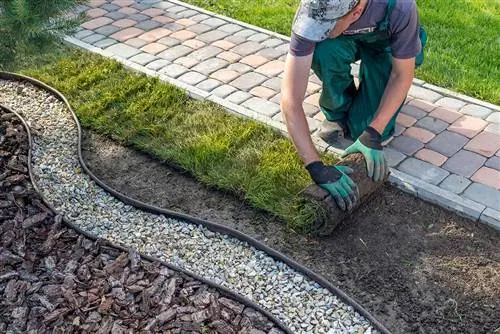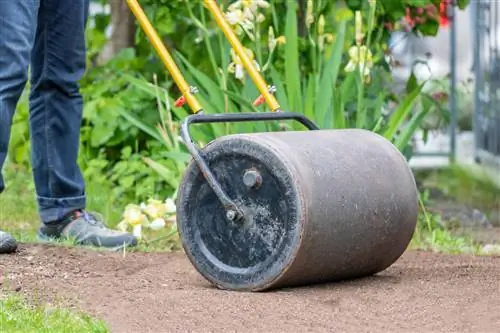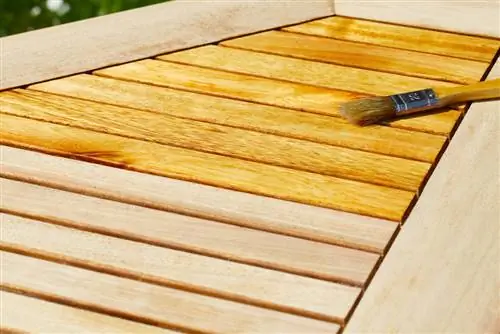- Author admin [email protected].
- Public 2023-12-16 16:46.
- Last modified 2025-01-23 11:19.
To save costs, you can lay turf yourself. It is important to take a precise inventory of the current soil in order to create the basis for good rooting of the new lawn. In addition, the type of grass should be adapted to the location.
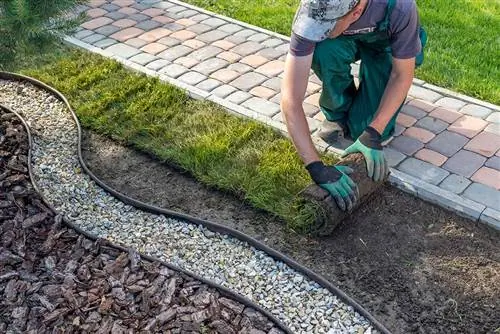
How is turf laid?
Rolled turf can be laid on old grass and on soil. To do this, the soil must be prepared by digging, scarifying or adding soil, sand and fertilizer. The earth is leveled with a roller and the turf is laid. Then roll, water and do not walk on for at least two weeks.
When will turf be laid?
Basically, rolled turf can be laidall year round. Only extremely high or low temperatures should be avoided. Most garden owners choose to lay them out in the spring. Residents of a new home often choose autumn as the time. If you want to lay turf in summer, you should pay attention to refrigerated transport when purchasing.
Rolled turf comes fresh from the field of specialized nurserieson pallets in the truckIn order to make optimal use of the space, the pieces of turf arerolled up like a long carpetHowever, the green stalks do not like to be rolled up and stacked under pressure. Therefore, laying should take place immediately after delivery. The rolls are distributed in the garden for temporary storage. If there is strong sunlight, a shady place should be chosen.
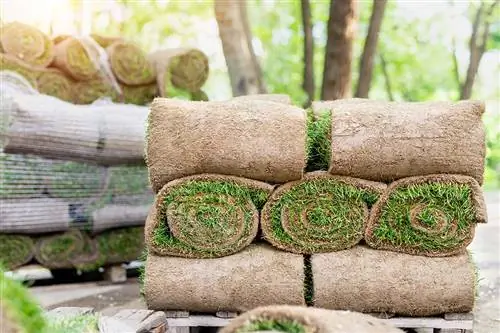
Rolled turf is delivered on pallets and should be processed as quickly as possible.
Instructions: Re-laying turf
The easiest way to lay turf is to start by removing the old turf. This creates the optimal basis for a weed-free surface on which new grass can grow.
To do this, do the following:
- Mowing the old lawn
- Remove the old turf with a spade or sod cutter
- Loosen the soil with a rake or tiller
- Check soil quality (pH value) and improve with sand or humus if necessary
- Apply lawn fertilizer and rake in if necessary
- Compact the soil crosswise and lengthways with a roller
- Rake the floor lightly and moisten it shortly before laying
- Laying rolled turf track by track
- Roll or press the lawn
- Water the lawn and do not walk on it for about two to three weeks
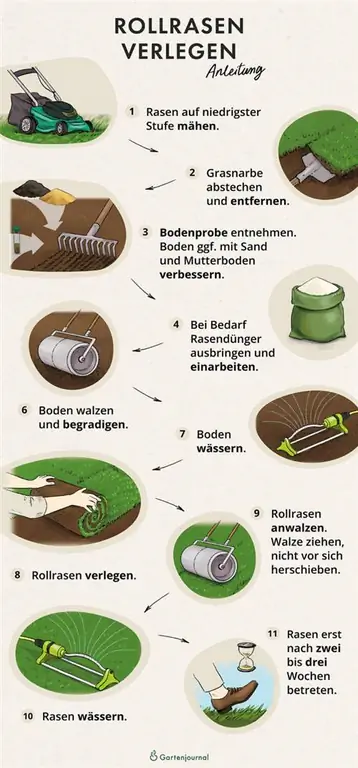
Material and tools
- Lawnmower
- Spade or sod cutter
- Rake
- if applicable Rotary tiller
- Lawn roller
- Lawn sprinkler
- Universal lawn fertilizer
- pH test strips
- Knife
Removing old lawn
Mowing
In order for the new lawn to grow well, the old one has to make room. First, the lawn is mowed at the lowest setting.
cutting the sod
Finally, remove the turf with a spade or, for larger areas, with a sod cutter. The old grass can be composted along with the roots.
Removing stones and roots
All coarse particles such as stones and roots should be picked up and removed. They cause unevenness and interfere with growth.
Prepare the floor
Improve soil structure
If the soil is too sandy, topsoil should be spread generously over the area. Heavy and clayey soil, however, should be loosened up with sand.
Determine pH value and fertilize
The pH value of the soil indicates whether the soil is acidic or basic. Lawn grows best on the latter. If the pH test shows a value below 7 (acidic), the soil needs to be improved with a little lime. In addition, the administration of a soil activator or universal lawn fertilizer has proven useful.
loose up and mix the soil
The soil is then loosened and mixed with sand or humus-rich soil, lime and fertilizer using a rake, depending on the desired improvement.
Adjust and compact soil
Lawn grows best on flat, relatively dense areas. Therefore, a roller is used next. You can borrow these from the hardware store for little money. This will now level the surface lengthwise and crosswise.
Rake and moisten
Shortly before the turf is spread, the soil should be loosened lightly and superficially with a rake. This means that the grass roots encounter less resistance and connect to the earth more quickly. The soil should also be slightly moistened.
Laying turf
Distribute roles
The rolls should be removed from the pallets immediately after delivery and distributed in the garden. This reduces the pressure on the rollers. In addition, the distances when laying are shorter.
Laying turf
The first piece is laid out on the furthest corner so that you don't have to constantly walk across the fresh grass. This is how things progress bit by bit. To avoid unnecessary cuts, lay along the longest side. Gaps, overlaps and intersections must be avoided.
Crop
Rarely lawns are exactly straight. If curves and plants get in the way, the roll must be cut to size. Curves can be cut precisely into the grass carpet with a knife.
Reels
When the lawn finally fits perfectly in the garden, the roller comes into play. Alternatively, a large board can be used for small areas. As before, move the roller across and lengthwise over the lawn so that it lies firmly on the ground. Pull the roller behind you to avoid leaving any marks in the rolled turf.
Water
The lawn is then watered so that it is moist right down to the roots. As a rule of thumb, there are around 15 to 20 liters of water per square meter. In summer, the lawn should be watered in the morning or evening, otherwise the liquid will evaporate too quickly.
Waiting time
The lawn must be kept consistently moist for about 14 days. The area should not be walked on during irrigation. After six weeks the floor is fully resilient.
Care
Mowing
The lawn mower can be used for the first time after seven to ten days. Beforehand, you should make sure that the blades are sharp. Shade lawns are shortened to around 6 centimeters, all other varieties to 4 centimeters. Mowing should take place once a week during the growing season.
Water
In summer, watering should be done daily if there is no rain and high temperatures. In spring and autumn there is no additional blasting due to the wetter climate.
Fertilize
A starter fertilizer can be spread on the lawn two weeks after laying. After another six weeks, a suitable seasonal fertilizer is used. As a rule, the lawn is supplied with fertilizer three times a year.
Verticutting
Scarifying is not necessary in the first year after laying out the turf. However, it can still be scarified to prevent moss and weeds. However, you should wait at least 12 weeks before scarifying for the first time.
Instructions: Laying rolled turf on old lawn
In order to lay turf quickly, it may be sufficient to mow the old turf as deeply as possible and scarify it into the lawn. To do this, proceed as follows:
- Mow the lawn as short as possible
- Dethatch deeply
- Remove loose grass and weeds
- Take a soil sample and check the pH value
- Loosen heavy soil with sand, improve sandy soil with humus
- If necessary, lime the soil and apply fertilizer
- Water the lawn lightly
- Laying turf
- Fasten with a roller
- Watering
- Do not walk on the lawn for approx. two to three weeks
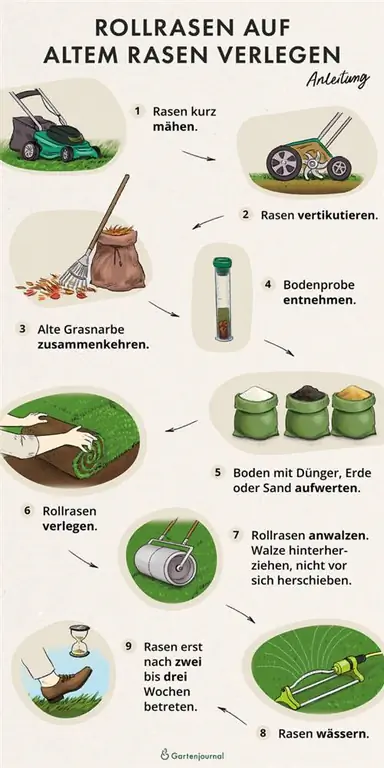
Material and tools
- Lawnmower
- Rake
- Scarifier
- Green manure seeds
- Lawn roller
- Lawn sprinkler
- Universal lawn fertilizer
- pH test strips
- Lime or humus (as soil improver)
- Knife
Prepare the floor
Mowing and scarifying
First, the lawn is mowed at the lowest setting. Then scarify the ground to the maximum working depth. You can compost the old grass clippings.
Leveling the floor
Existing dents or depressions should be filled with garden soil or lawn substrate. Otherwise, spreading and growing the turf will be more difficult.
measuring pH value
The pH value of the soil indicates whether the soil is acidic or basic. Lawn grows best on the latter. So if the pH test shows a value below 7 (acidic), the soil needs to be improved with a little lime.
Fertilize
A soil activator or universal lawn fertilizer can be added to the soil before laying.
Laying turf
Distribute roles
The rolls should be removed from the pallets immediately after delivery and distributed in the garden. This reduces the pressure on the rollers. In addition, the distances when laying are shorter.
Laying turf
The first piece is laid out on the furthest corner so that you don't have to constantly walk across the fresh grass. This is how things progress bit by bit. To avoid unnecessary cuts, lay along the longest side. Gaps, overlaps and intersections must be avoided.
Crop
Rarely lawns are exactly straight. If curves and plants get in the way, the roll must be cut to size. Curves can be cut precisely into the grass carpet with a knife.
Reels
The first piece is laid out on the furthest corner so that you don't have to constantly walk across the fresh grass. This is how things progress bit by bit. To avoid unnecessary cuts, lay along the longest side. Gaps, overlaps and intersections must be avoided.
Water
The lawn is then watered so that it is moist right down to the roots. As a rule of thumb, there are around 15 to 20 liters of water per square meter. In summer, the lawn should be watered in the morning or evening, otherwise the liquid will evaporate too quickly.
Adapt environment to elevated ground level
Since the old turf was not removed, the ground level rises by a few centimeters. Connection edges of the paving may need to be adjusted.
Waiting time
The lawn must be kept consistently moist for about 14 days. The area should not be walked on during irrigation. After six weeks the floor is fully resilient.
Care
Mowing
When the lawn finally fits perfectly in the garden, the roller comes into play. Alternatively, a large board can be used for small areas. As before, move the roller across and lengthwise over the lawn so that it lies firmly on the ground. Pull the roller behind you so that there are no footprints on the new turf.
Water
In summer, watering should be done daily if there is no rain and high temperatures. In spring and autumn there is no additional blasting due to the wetter climate.
Fertilize
A starter fertilizer can be spread on the lawn two weeks after laying. After another six weeks, a suitable seasonal fertilizer is used. As a rule, the lawn is supplied with fertilizer three times a year.
Verticutting
Scarifying is not necessary in the first year after laying out the turf. However, it can still be scarified to prevent moss and weeds. However, you should wait at least 12 weeks before scarifying for the first time.
Instructions: Laying turf on a fallow area
The lawn mower can be used for the first time after seven to ten days. Beforehand, you should make sure that the blades are sharp. Shade lawns are shortened to around 6 centimeters, all other varieties to 4 centimeters. Mowing can take place once a week during the growing season.
- Check pH value
- Loosen heavy soil with sand, improve sandy soil with a little humus or topsoil if necessary
- Apply green manure
- Mow and incorporate green manure at the lowest setting
- If applicable. Apply starter fertilizer
- Loosen and mix the soil
- Fasten with a roller
- Applying the turf
- Reattach with a roller
- Watering
- Do not walk on the lawn for approx. two to three weeks

Material and tools
- Lawnmower
- Rake
- Scarifier
- Green manure seeds
- Lawn roller
- Lawn sprinkler
- Universal lawn fertilizer
- pH test strips
- Lime or humus (as soil improver)
- Knife
Prepare the floor
Improve soil structure
If the soil is too sandy, topsoil should be spread generously over the area. Heavy and clayey soil, however, should be loosened up with sand.
Apply green manure and mow it down
When building houses, laying turf on fallow areas is common practice. Under certain circumstances, it may be advisable to invest the time in green manure and thus supply the soil with important nutrients and improve the soil quality. The green manure is mowed down before flowering and incorporated into the soil. If you don't have the time, you can use lawn fertilizer.
loose up and mix the soil
Depending on the improvement, the soil is then loosened and mixed with sand or humus-rich soil, lime and fertilizer using a rake.
Adjust and compact soil
Lawn grows best on flat, relatively dense areas. Therefore, a roller is used next. You can borrow these from the hardware store for little money. This will now level the surface lengthwise and crosswise.
Rake and moisten
Shortly before the turf is spread, the soil should be loosened lightly and superficially with a rake. This means that the grass roots encounter less resistance and connect to the earth more quickly. The soil should also be slightly moistened.
Laying turf
Distribute roles
The rolls should be removed from the pallets immediately after delivery and distributed in the garden. This reduces the pressure on the rollers. In addition, the distances when laying are shorter.
Embarrassed
The first piece is laid out on the furthest corner so that you don't have to constantly walk across the fresh grass. This is how things progress bit by bit. To avoid unnecessary cuts, lay along the longest side. Gaps, overlaps and intersections must be avoided.
Crop
Rarely lawns are exactly straight. If curves and plants get in the way, the roll must be cut to size. Curves can be cut precisely into the grass carpet with a knife.
Rolling with roller or board
Ready-made seed mixtures for the lawn can be found in specialist stores. Typical green manure plants include yellow mustard, lupins, summer rapeseed and summer vetch. They root deeply into the soil and thereby loosen it. They also bind minerals in the soil. The online provider Rollrasen-Rudi recommends a mixture of broad beans, Persian clover and lupins. Applying green manure is optional and can also be replaced by using lawn fertilizer.
Water
The lawn is then watered so that it is moist right down to the roots. As a rule of thumb, there are around 15 to 20 liters of water per square meter. In summer, the lawn should be watered in the morning or evening, otherwise the liquid will evaporate too quickly.
Waiting time
The lawn must be kept consistently moist for about 14 days. The area should not be walked on during irrigation. After six weeks the floor is fully resilient.
Care
Mowing
The lawn mower can be used for the first time after seven to ten days. Beforehand, you should make sure that the blades are sharp. Shade lawns are shortened to around 6 centimeters, all other varieties to 4 centimeters. Mowing should take place once a week during the growing season.
Water
In summer, watering should be done daily if there is no rain and high temperatures. In spring and autumn there is no additional blasting due to the wetter climate.
Fertilize
A starter fertilizer can be spread on the lawn two weeks after laying. After another six weeks, a suitable seasonal fertilizer is used. As a rule, the lawn is supplied with fertilizer three times a year.
Verticutting
Scarifying is not necessary in the first year after laying out the turf. However, it can still be scarified to prevent moss and weeds. However, you should wait at least 12 weeks before scarifying for the first time.
Costs for rolled turf
| Rolled turf type | Costs | Suitable for |
|---|---|---|
| Rolled turf | 2 to 10 euros/m² | |
| Play and utility lawn | 5, 65 euros/m² | Private gardens, lawn |
| Playground | 4, 75 euros/m² | higher load |
| Shaded lawn | 8, 05 euros/m² | (semi-)shady locations |
| Mediterranean lawn | 6 to 10 euros/m² | dry surfaces |
| Premium turf | 4 to 10 euros/m² | representative areas |
| Sports turf | 5, 95 euros/m² | highly contaminated areas |
| Grass-herb-lawn | 8, 30 euros/m² | natural gardens, roof gardens |
| fragrant lawn | 9, 15 euros/m² | natural gardens, embankments |
How long does turf last?
The first piece is laid out on the furthest corner so that you don't have to constantly walk across the fresh grass. This is how things progress bit by bit. To avoid unnecessary cuts, lay along the longest side. Gaps, overlaps and intersections must be avoided.
Weeds and diseases in turf
Fighting weeds
When the lawn finally fits perfectly in the garden, the roller comes into play. Alternatively, a large board can be used for small areas. As before, move the roller across and lengthwise over the lawn so that it lies firmly on the ground. Pull the roller behind you to avoid leaving marks in the ground.
Preventing diseases
| Illness | Appearance | Combat | Prevention |
|---|---|---|---|
| Snow mold | gray-brown spots (up to 25 cm) | Scarifying, scattering sand | Avoid waterlogging, fertilizing |
| Gray snow mold | gray-brown spots (up to 50 cm), individual stalks silvery | Removing leaves and snow, scarifying | Optimize fertilizer, keep lawn free |
| Blacklegs | light green to bronze ring-shaped spots | Fertilizer | Fertilizer |
| Dollarspots | small, faded spots | water regularly | fertilize especially in summer |
| Leaf spot disease | irregular yellowing | Reduce watering | don’t mow too short |
| Rust disease | yellow to black pustules on the stalks | water more often | no watering in the evenings |
| Root rot | slimy stalks, brown spots | Liming and watering | Avoid waterlogging, check pH value |
| Witch Rings | dark green rings and fungal growth | Water the rings specifically, possibly fight fungi | Avoid water shortage |
| Anthracnose | black dots on the stalks | Don't walk on the lawn, fertilize more | do not cut below 4 cm |
Repair and improve turf
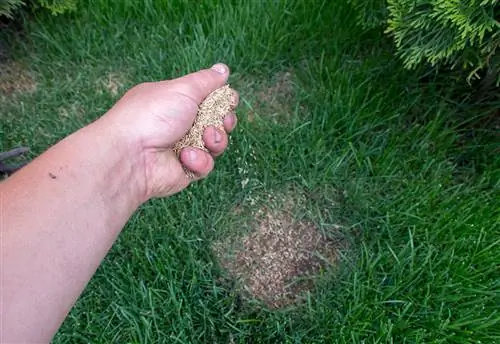
Rolled turf can also have bare spots and can be repaired by reseeding.
The lawn mower can be used for the first time after seven to ten days. Beforehand, you should make sure that the blades are sharp. Shade lawns are shortened to around 6 centimeters, all other varieties to 4 centimeters. Mowing should take place once a week during the growing season.
Advantages of rolled turf
- less work overall than sowing
- quick success
- initially fewer problems with weeds
Disadvantages of rolled turf
- high price
- the roles are very heavy
- inflexible because the turf has to be laid immediately after delivery
FAQ
How do you prepare the area for turf?
The area should be flat and free of stones and roots. The soil is consolidated using a roller.
Can turf be laid when it rains?
Yes, turf can be laid when it rains. The floor should be moist when laying.
Which turf is the best?
Rolled turf comes in different varieties that favor different uses and locations. In most cases, a sports and play turf is sufficient.
How is turf laid?
Rolled turf is quickly distributed from the pallet in the garden and then rolled out starting from one corner. Some carpets may need to be cut.
When will turf be laid?
Rolled turf can be laid all year round. However, spring and autumn are recommended as optimal times.

